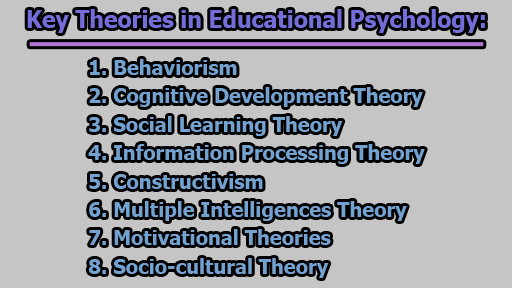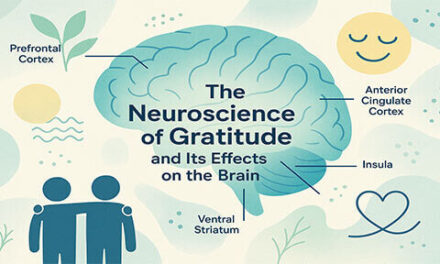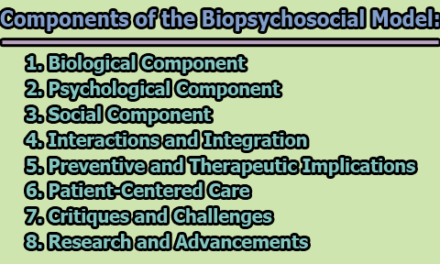Key Theories in Educational Psychology:
Educational psychology is a multidisciplinary field that combines principles from psychology and education to understand how individuals learn and develop in educational settings. Numerous theories have been proposed over the years to explain various aspects of learning, cognition, and motivation. In this article, we will delve into some key theories in educational psychology, examining their foundations, contributions, and implications for teaching and learning.
1. Behaviorism: Behaviorism, a foundational theory in educational psychology, originated from the work of B.F. Skinner and John B. Watson. Rooted in the idea that observable behaviors can be studied objectively, behaviorism focuses on the relationship between stimuli and responses, emphasizing the role of reinforcement and punishment in shaping behavior (Skinner, 1953).
One key aspect of behaviorism is Skinner’s concept of operant conditioning, which posits that behaviors are strengthened or weakened based on the consequences that follow them. Positive reinforcement involves the presentation of a rewarding stimulus after a desired behavior, while negative reinforcement entails the removal of an aversive stimulus, both of which increase the likelihood of the behavior recurring (Skinner, 1938). On the other hand, punishment aims to decrease the likelihood of a behavior by introducing an aversive stimulus (Skinner, 1957).
In the context of education, behaviorist principles have influenced teaching methods such as drill-and-practice, where repeated exposure and reinforcement of content contribute to learning (Skinner, 1968). Skinner’s work has also been applied in behavior modification strategies, which involve systematically reinforcing desired behaviors and extinguishing undesired ones (Martin & Pear, 2015).
While behaviorism has faced criticism for oversimplifying the learning process and neglecting cognitive aspects, its principles have undeniably contributed to our understanding of how external factors influence behavior and learning outcomes (O’Donnell, Reeve, & Smith, 2017). The behaviorist approach remains relevant in educational settings, where the careful application of reinforcement and punishment can shape and modify student behaviors to create a conducive learning environment.
2. Cognitive Development Theory: Jean Piaget’s Cognitive Development Theory revolutionized the field of educational psychology by shifting the focus from observable behaviors to internal cognitive processes. Piaget proposed that children actively construct their knowledge through a series of developmental stages, each characterized by distinct cognitive abilities and ways of understanding the world (Piaget, 1952).
Piaget identified four stages of cognitive development: the sensorimotor stage (0-2 years), preoperational stage (2-7 years), concrete operational stage (7-11 years), and formal operational stage (11 years and older). Each stage represents a qualitative shift in thinking and reasoning abilities, with children progressing through these stages in a fixed sequence (Piaget, 1970).
One of the fundamental concepts in Piaget’s theory is the notion of assimilation and accommodation. Assimilation involves incorporating new information into existing cognitive structures, while accommodation requires modifying existing structures to accommodate new information. This dynamic interplay between assimilation and accommodation contributes to cognitive growth and development (Piaget, 1964).
Educational implications of Piaget’s theory include the importance of considering students’ cognitive developmental levels when designing instruction. Piaget suggested that teachers should provide developmentally appropriate challenges to foster cognitive growth (Piaget, 1976). For example, in the concrete operational stage, students may benefit from hands-on, concrete experiences that allow them to manipulate and interact with materials to enhance their understanding of abstract concepts.
While Piaget’s theory has been influential, it has also been critiqued for potential cultural and individual variations not adequately addressed in his stage theory (Vygotsky, 1962). Nevertheless, the enduring impact of Cognitive Development Theory lies in its emphasis on the active role of learners in constructing knowledge and the significance of developmental stages in shaping educational practices.
3. Social Learning Theory: Albert Bandura’s Social Learning Theory expands on traditional behaviorist principles by incorporating cognitive and observational aspects of learning. Bandura argued that individuals learn not only through direct reinforcement but also by observing the behaviors of others and the consequences that follow (Bandura, 1977). This theory emphasizes the importance of social modeling, imitation, and the role of cognitive processes in learning.
One of the key concepts in Social Learning Theory is observational learning, where individuals acquire new behaviors by watching others. Bandura’s famous Bobo doll experiment demonstrated that children exposed to aggressive behavior towards a doll were more likely to imitate that behavior when given the opportunity (Bandura, Ross, & Ross, 1961). This highlighted the influence of modeling and observational learning on behavior acquisition.
Central to Social Learning Theory is the concept of self-efficacy, which refers to an individual’s belief in their ability to succeed in specific situations. Bandura posited that self-efficacy influences the choices people make, their level of effort, and their persistence in the face of challenges (Bandura, 1997). In an educational context, fostering students’ self-efficacy involves providing opportunities for success, offering positive feedback, and encouraging a growth mindset.
Teachers can apply Social Learning Theory by incorporating positive role models, creating collaborative learning environments, and using modeling to demonstrate desired behaviors. Collaborative group activities, peer tutoring, and cooperative learning settings align with Bandura’s emphasis on the social nature of learning (Bandura & Walters, 1963). Additionally, teachers can promote self-regulation by guiding students in setting realistic goals and monitoring their progress, which contributes to the development of self-efficacy (Zimmerman, 1989).
While acknowledging the importance of external reinforcement, Social Learning Theory underscores the critical role of cognitive processes and social influences in shaping behavior. By integrating observational learning and self-efficacy considerations, educators can enhance the effectiveness of their instructional strategies and contribute to the development of well-rounded, self-motivated learners.
4. Information Processing Theory: Information Processing Theory, rooted in cognitive psychology, views the mind as a complex information-processing system analogous to a computer. This theory explores how individuals encode, store, retrieve, and manipulate information as they engage in learning and problem-solving tasks (Atkinson & Shiffrin, 1968).
One central aspect of Information Processing Theory is the concept of working memory, which is the system responsible for temporarily holding and manipulating information. Working memory capacity influences a person’s ability to process complex information and solve problems (Baddeley & Hitch, 1974). Educators can support students in managing their working memory by presenting information in a structured and organized manner, breaking complex tasks into smaller steps, and providing opportunities for rehearsal and practice.
Another key component is long-term memory, where information is stored for an extended period. The process of transferring information from working memory to long-term memory is facilitated by repetition, meaningful associations, and effective encoding strategies (Anderson, 1983). Educational strategies such as mnemonic devices, concept mapping, and chunking information into manageable units align with principles derived from Information Processing Theory.
The theory also emphasizes the importance of attention, as selective attention directs individuals to relevant information while filtering out irrelevant stimuli (Broadbent, 1958). Teachers can enhance students’ attention by minimizing distractions, using visual aids, and providing clear instructions.
Information Processing Theory is particularly relevant in educational contexts that involve complex cognitive tasks, such as problem-solving, critical thinking, and decision-making. By understanding the cognitive processes involved in information processing, educators can design instructional materials and activities that align with the natural capacities of learners’ cognitive systems, ultimately optimizing the learning experience.
5. Constructivism: Constructivism, as a learning theory, places emphasis on the active role of learners in constructing their own knowledge through experiences, reflection, and interaction with their environment (Piaget, 1976; Vygotsky, 1978). It is a theory that has gained prominence in educational psychology, providing a framework for understanding how students learn and how teachers can facilitate meaningful learning experiences.
Lev Vygotsky, a key figure in the development of constructivism, introduced the concept of the zone of proximal development (ZPD). The ZPD represents the range of tasks that a learner can perform with the help of a more knowledgeable person, such as a teacher or peer (Vygotsky, 1978). By scaffolding instruction—providing support and guidance within the ZPD—educators can assist students in reaching higher levels of understanding and competence.
In the constructivist view, learning is an active, social process. Jean Piaget’s theory aligns with this perspective, emphasizing that learners actively assimilate new information into their existing cognitive structures and accommodate their understanding as needed (Piaget, 1964). Constructivist approaches to teaching involve creating opportunities for students to explore, question, and apply their knowledge in real-world contexts.
Constructivism rejects the idea of a one-size-fits-all curriculum and instead advocates for learner-centered, inquiry-based methods. Project-based learning, problem-solving activities, and collaborative projects are common strategies aligned with constructivist principles (Brooks & Brooks, 1993). These approaches encourage students to construct meaning from their experiences, fostering a deeper and more enduring understanding of the material.
Critics argue that the individualized nature of constructivism may lead to inconsistencies in student learning outcomes. However, proponents assert that this diversity reflects the natural variability in how individuals learn and that constructivism accommodates this variability by tailoring instruction to students’ unique needs and abilities (Jonassen, 1991).
Consequently, constructivism provides a theoretical foundation for teaching practices that prioritize active engagement, collaborative learning, and the integration of new knowledge into existing cognitive structures, ultimately promoting a more meaningful and enduring understanding of the subject matter.
6. Multiple Intelligences Theory: Howard Gardner’s Multiple Intelligences Theory challenges the traditional notion of a single, general intelligence by proposing that individuals possess multiple distinct intelligences, each representing different ways of processing information and solving problems (Gardner, 1983). Gardner initially identified seven intelligences: linguistic, logical-mathematical, spatial, musical, bodily-kinesthetic, interpersonal, and intrapersonal. Later, he added the naturalistic intelligence to the list (Gardner, 1999).
Each intelligence represents a unique set of abilities and talents. For example, linguistic intelligence involves proficiency in language and communication, while bodily-kinesthetic intelligence pertains to physical coordination and skill. Gardner argued that recognizing and cultivating these diverse intelligences is essential for promoting a more comprehensive and personalized approach to education.
Educators applying the Multiple Intelligences Theory acknowledge that students have different strengths and learning preferences. Designing activities that cater to various intelligences allows students to engage with the material in ways that resonate with their unique abilities (Gardner, 1993). For instance, a lesson on ancient civilizations might involve a linguistic learner writing a historical narrative, a spatial learner creating a visual timeline, and a musical learner composing a song related to the topic.
Critics of the theory argue that the concept of multiple intelligences lacks empirical support and may not align with traditional psychometric measures of intelligence (Brody & Mills, 1997). However, Gardner’s theory has significantly influenced educational practices by promoting a more inclusive understanding of intelligence that extends beyond traditional academic measures.
Subsequently, the Multiple Intelligences Theory encourages educators to value and nurture a broad spectrum of talents in their students. By recognizing and accommodating diverse intelligences, educators can create a more inclusive and enriching learning environment that supports each student’s unique strengths and potential.
7. Motivational Theories: Motivation is a critical factor influencing learning outcomes, and various motivational theories have been proposed to understand the driving forces behind human behavior in educational settings.
Abraham Maslow’s Hierarchy of Needs, outlined in his seminal work “A Theory of Human Motivation” (1943), posits that individuals are motivated by a hierarchy of needs that must be satisfied in a specific order. The hierarchy includes physiological needs, safety, love and belongingness, esteem, and self-actualization. In an educational context, teachers can address students’ basic needs, such as providing a safe and supportive learning environment, before addressing higher-order needs like self-esteem and self-actualization.
Achievement motivation, as conceptualized by Atkinson (1957) and McClelland (1987), focuses on individuals’ desire for success and fear of failure as key motivators. According to this theory, individuals with a high need for achievement are driven to excel and take on challenging tasks, while those with a high fear of failure may avoid challenging situations to protect their self-esteem. Educators can leverage achievement motivation by providing opportunities for success and offering constructive feedback to boost students’ confidence and motivation to excel.
Goal-setting theory, proposed by Locke and Latham (1990), suggests that setting specific and challenging goals can enhance motivation and performance. Clear, measurable objectives provide individuals with a sense of direction and purpose, motivating them to exert effort and persist in the face of challenges. Teachers can apply goal-setting theory by involving students in the goal-setting process, encouraging them to set realistic yet challenging objectives for their academic endeavors.
Self-determination theory, developed by Deci and Ryan (1985), posits that individuals are inherently motivated to pursue activities that fulfill three psychological needs: autonomy, competence, and relatedness. In an educational context, providing students with choices and autonomy, acknowledging their achievements, and fostering positive relationships can enhance intrinsic motivation and engagement.
These motivational theories collectively emphasize the importance of understanding and addressing students’ psychological needs, creating a supportive and challenging learning environment, and promoting a sense of autonomy and competence. By integrating these motivational principles into instructional practices, educators can inspire students to become active and motivated learners, leading to improved academic performance and a positive attitude towards learning.
8. Socio-cultural Theory: Socio-cultural theory, prominently associated with Lev Vygotsky, underscores the social and cultural context in which learning occurs. Vygotsky argued that cognitive development is deeply intertwined with social interactions and cultural influences, challenging the notion that learning is solely an individual, internal process (Vygotsky, 1978).
One of the central tenets of socio-cultural theory is the Zone of Proximal Development (ZPD), which represents the range of tasks a learner can perform with the assistance of a more knowledgeable person. Vygotsky emphasized the importance of social interaction and collaboration in the ZPD, suggesting that learners benefit from guided participation and scaffolding provided by a teacher, peer, or a more knowledgeable other (Vygotsky, 1978).
Socio-cultural theory also highlights the role of cultural tools, such as language, in shaping cognitive development. Language, according to Vygotsky, is not only a means of communication but a tool for thought. Through language, individuals internalize knowledge, engage in private speech (self-talk), and gradually develop higher mental functions (Vygotsky, 1986).
Collaborative learning, peer interaction, and cooperative group activities are instructional strategies aligned with socio-cultural theory. By fostering social interactions and providing opportunities for students to work together, educators can enhance the learning experience and promote cognitive development (Tharp & Gallimore, 1988).
Vygotsky’s socio-cultural theory has implications for educational practices, emphasizing the importance of creating a supportive social environment and recognizing the cultural context in which learning occurs. The theory encourages educators to be aware of students’ diverse backgrounds, incorporate culturally relevant materials, and promote collaborative learning experiences that leverage the social nature of cognition.
While socio-cultural theory has been influential, it has also faced critiques, including concerns about its applicability across different cultural contexts and potential oversights in acknowledging individual differences. Nevertheless, the emphasis on the social and cultural dimensions of learning has had a profound impact on educational practices, highlighting the interconnectedness of social interactions, culture, and cognitive development in the learning process.
In conclusion, educational psychology, with its diverse range of theories, provides educators with valuable frameworks for understanding how students learn and develop. By incorporating insights from behaviorism, cognitive development theory, social learning theory, information processing theory, constructivism, multiple intelligences theory, motivational theories, and socio-cultural theory, educators can tailor their teaching methods to meet the diverse needs of learners. As educational psychology continues to evolve, it remains a vital field in shaping effective teaching practices and optimizing the learning experience for students worldwide.
References:
- Anderson, J. R. (1983). A spreading activation theory of memory. Journal of Verbal Learning and Verbal Behavior, 22(3), 261–295.
- Bandura, A. (1977). Social learning theory. Englewood Cliffs, NJ: Prentice-Hall.
- Bandura, A. (1997). Self-efficacy: The exercise of control. W. H. Freeman and Company.
- Bandura, A., Ross, D., & Ross, S. A. (1961). Transmission of aggression through imitation of aggressive models. Journal of Abnormal and Social Psychology, 63(3), 575–582.
- Bandura, A., & Walters, R. H. (1963). Social learning and personality development. Holt, Rinehart & Winston.
- Brody, N., & Mills, C. J. (1997). Intelligence and experience: A neo-Piagetian approach. In R. J. Sternberg & J. C. Kaufman (Eds.), Human abilities (pp. 93–122). Cambridge University Press.
- Brooks, J. G., & Brooks, M. G. (1993). In search of understanding: The case for constructivist classrooms. Association for Supervision and Curriculum Development.
- Broadbent, D. E. (1958). Perception and communication. Oxford, England: Pergamon Press.
- Deci, E. L., & Ryan, R. M. (1985). Intrinsic motivation and self-determination in human behavior. Plenum.
- Gardner, H. (1983). Frames of mind: The theory of multiple intelligences. Basic Books.
- Gardner, H. (1993). Multiple intelligences: The theory in practice. Basic Books.
- Gardner, H. (1999). Intelligence reframed: Multiple intelligences for the 21st century. Basic Books.
- Jonassen, D. H. (1991). Evaluating constructivist learning. Educational Technology, 31(9), 28–33.
- Locke, E. A., & Latham, G. P. (1990). A theory of goal setting and task performance. Prentice-Hall.
- Martin, G., & Pear, J. (2015). Behavior modification: What it is and how to do it (10th ed.). Psychology Press.
- Maslow, A. H. (1943). A theory of human motivation. Psychological Review, 50(4), 370–396.
- McClelland, D. C. (1987). Human motivation. CUP Archive.
- O’Donnell, A. M., Reeve, J., & Smith, J. K. (2017). Educational psychology: Reflection for action. Wiley.
- Piaget, J. (1952). The origins of intelligence in children. International Universities Press.
- Piaget, J. (1964). Development and learning. In R. E. Ripple & V. N. Rockcastle (Eds.), Piaget rediscovered: A report of the conference on cognitive studies and curriculum development (pp. 7–20). Cornell University.
- Piaget, J. (1970). Science of education and the psychology of the child. Orion Press.
- Piaget, J. (1976). Piaget’s theory. In P. H. Mussen (Ed.), Carmichael’s manual of child psychology (Vol. 1, pp. 703–732). Wiley.
- Piaget, J. (1986). Play, dreams, and imitation in childhood. Norton.
- Skinner, B. F. (1938). The behavior of organisms: An experimental analysis. Appleton-Century.
- Skinner, B. F. (1953). Science and human behavior. Free Press.
- Skinner, B. F. (1957). Verbal behavior. Copley.
- Skinner, B. F. (1968). The technology of teaching. Appleton-Century-Crofts.
- Tharp, R. G., & Gallimore, R. (1988). Rousing minds to life: Teaching, learning, and schooling in social context. Cambridge University Press.
- Vygotsky, L. S. (1962). Thought and language. MIT Press.
- Vygotsky, L. S. (1978). Mind in society: The development of higher psychological processes. Harvard University Press.
- Vygotsky, L. S. (1986). Thought and language (A. Kozulin, Trans.). MIT Press.
- Zimmerman, B. J. (1989). A social cognitive view of self-regulated academic learning. Journal of Educational Psychology, 81(3), 329–339.

Library Lecturer at Nurul Amin Degree College










